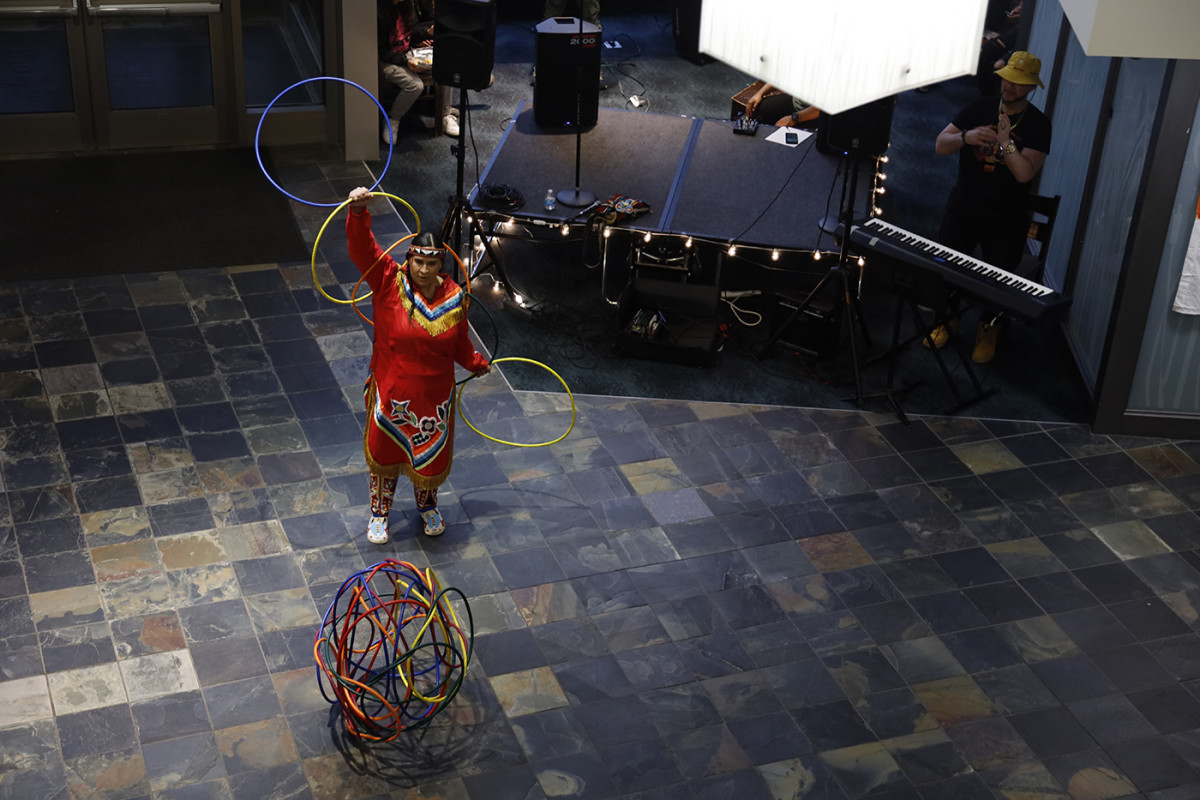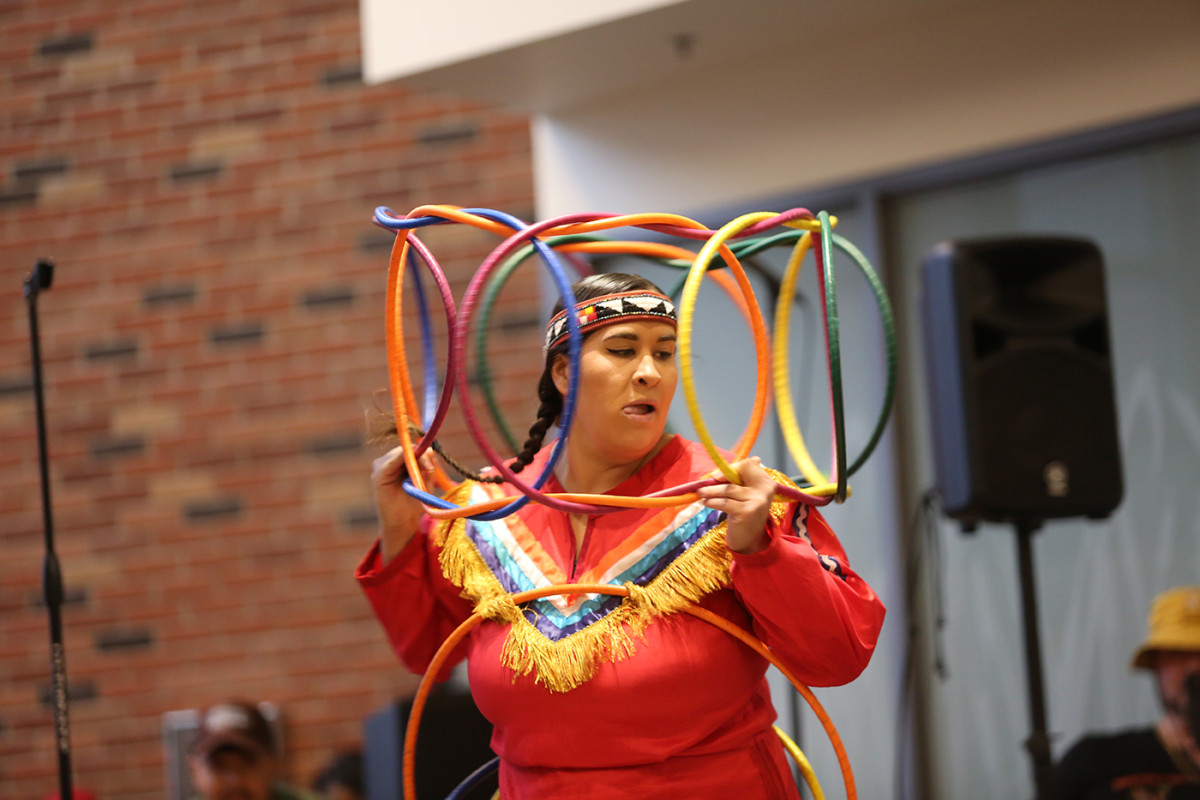News Based on facts, either observed and verified directly by the reporter, or reported and verified from knowledgeable sources.
History through hoop dancing
 Hoop dancer Starr Chief Eagle performs a dance at Bethel University’s OIX Block Party event. Before starting her performance, she shows off the actions she will do during the dance, bending the hoops into shapes like butterflies, birds, and bow and arrows. (Kathryn Kovalenko, special to ICT)
Hoop dancer Starr Chief Eagle performs a dance at Bethel University’s OIX Block Party event. Before starting her performance, she shows off the actions she will do during the dance, bending the hoops into shapes like butterflies, birds, and bow and arrows. (Kathryn Kovalenko, special to ICT)
Starr Chief Eagle tells a story of culture, history and family through hoop dancing
Starr Chief Eagle stood in front of a crowd of onlookers as a drum beat began to swell from the large speakers behind her. She readied her body, preparing to reach for the first of 22 hoops that lay interlaced in front of her.
Chief Eagle had purchased a new red dress and flown from the Pine Ridge Reservation in South Dakota to Arden Hills, Minnesota, earlier that day to stand in front of the quieting crowd at a diversity block party. Children, college students and adults waited underneath a staircase in Bethel University’s Brushaber Commons, standing, sitting in inflated inner tubes or at tables and chairs pushed to the edges of the room. Before starting her performance, Chief Eagle had shown different figures with her hoops, encouraging the crowd to shout out what each action made them think of. Exclamations such as from “Butterfly!” and “Bird!” and “Mickey Mouse!” permeated the hall as she added more hoops to the performance. Then, she stood still, taking a breath as the real dance began.
“I truly do believe that hoop dancing does heal in some way or another,” Chief Eagle said. “It heals those who are watching it. It heals those who are doing it.”

An outlawed tradition returns
Chief Eagle grew up between two realms in South Dakota, living in Rapid City with her mother and at the Pine Ridge Reservation with her father. She began to learn dance as soon as she could hold her first hoop in her small hands. Her older siblings learned to hoop dance the same way, from their father, she said, who had brought the Lakota tradition back to Pine Ridge after it was outlawed by the federal government in 1883. As a student of both worlds, Chief Eagle would question the differences in what she was taught from reservation elders versus books in school. She began to discern between what she had been told and what was true. Her first name, Starr, raised questions from students and mispronunciations from teachers, leaving her feeling alienated and shy when faced with stereotypes.
“There’s a lot of Native peoples who don’t know their language, don’t know their history, don’t know their culture,” Chief Eagle said. “There’s a lot of us that feel like we’re in the dark … and you could be the individual that makes the choice to reconnect to your culture.”
As a young girl, Chief Eagle wanted to get a job that would give her family stability. She wanted to provide for her aunts and uncles, cousins and grandparents.
“I thought, well, that’s gotta be like, a lawyer or doctor,” Chief Eagle said.
When she started to perform hoop dances on her own, she began to truly learn about and connect to her culture, she said. She decided she wanted to keep dancing.
Chief Eagle found this connection to her culture through people who taught her different parts of the culture, from her father who introduced her and many others to hoop dancing, to Darrell Red Cloud, who taught her to make jewelry and beadwork which she could use to fund her travels. Each interaction encouraged her to further learn about her culture, family and history, and to educate others in the same ways.

Finding her voice
For Chief Eagle, hoop dancing gave her a voice that she didn’t have in school. It was a way to get outside of her comfort zone and to share her real history.
“Do what we can for today,” Chief Eagle said. “Together we can take healing steps forward, and I believe that is through understanding and I believe that’s through education.”
When Chief Eagle performs, she wants to be present in the moment in order to feel the energy of the people watching. She wants them to come away with a positive and memorable experience.
“That’s one of my favorite things: I can see how what I’m doing is impacting other people,” Chief Eagle said.
During her performances, Chief Eagle encourages excitement and questions, urging the crowd to cheer and yell about what her dance meant to them. She tells a story, making it clear that this story can carry different meanings depending on the viewer. To her, the 22 hoops represent her life, whirling through her history in a rainbow of multicolored electric tape.

